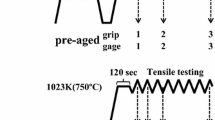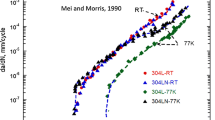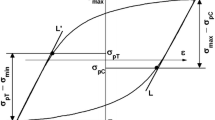Abstract
The potential use of liquid lithium, in conjunction with several of the advanced energy generation systems currently under study, has led to many recent investigations of the effects of liquid lithium on the engineering properties of various materials.12 Particular emphasis has been placed on understanding the corrosion processes in liquid lithium which lead to material degradation. The mode of corrosion attack has been shown to be controlled by temperature,3 nitrogen content in the liquid lithium,3 alloy composition,4 and heat treatment.5 For example, an increase in nitrogen content in the liquid lithium accelerates both weight loss and grain boundary penetration rates in 304 L stainless steel,3 and alters the relative rates of both processes to promote grain boundary penetration at high nitrogen concentrations. The grain boundary penetration rate in pure Armco iron has been shown to be enhanced with the application of either a tensile or compressive stress.6 Furthermore, lithium penetrated grain boundaries have been shown to lack mechanical integrity.1 Thus for proper design of materials to contain liquid lithium, the interaction of stress with the various corrosion processes must be understood. In this note, the results of a study of the fatigue crack propagation characteristics of 2 1/4 Cr-1 Mo steel in liquid lithium are presented.
Similar content being viewed by others
References
D. L. Olson and D. K. Matlock:Energy, 1978, vol. 3, pp. 315–23.
V. E. Selle and D. L. Olson:Materials Considerations in Liquid Systems in Power Generation, G. A. Whitlow and N. J. Hoffman, eds., pp. 15–22, NACE, Houston, Texas, 1978.
D. L. Olson, G. N. Reser, and D. K. Matlock:Corrosion, 1980, vol. 36, pp. 140–40.
G. R. Edwards, D. A. Bates, and D. L. Olson:Corrosion/79, NACE, Atlanta, Georgia, March 1979.
T. L. Anderson, G. R. Edwards, N. J. Hoffman, and J. B. Lumsden III:Interganular Penetration of 2 1/4 Cr-1 Mo Weldments by a Lithium-Lead Liquid, Second International Conference on Liquid Metal Technology in Energy Production, April 1980, Richland, Washington.
T. A. Whipple, D. L. Olson, W. L. Bradley, and D. K. Matlock:Nucl. Techno!., 1978, vol. 39, pp. 75.
D. L. Hammon, S. K. DeWeese, D. K. Matlock, and D. L. Olson:Closed Loop, 1979, vol. 9, pp. 3–11.
R. G. Baker and J. Nutting:J. Iron Steel Inst., 1959, vol. 192, pp. 257–68.
P. C. Paris and F. Erdogan: Trans. ASME, Series B, 1963, vol. 85, pp. 528–34.
H. D. Soloman and L. F. Coffin, Jr.:Fatigue at Elevated Temperatures, ASTM STP 520, pp. 112–21, American Society for Testing and Materials, Philadelphia, 1973.
M. H. Kamdar:Prog. Mater. Sci., 1973, vol. 15, Part 4, pp. 289–374.
Author information
Authors and Affiliations
Additional information
Formerly Graduate Research Assistant at Colorado School of Mines
Rights and permissions
About this article
Cite this article
Spencer, R.E., Deweese, S.K., Matlock, D.K. et al. Fatigue crack propagation characteristics of 2 1/4 Cr-1 Mo steel in liquid lithium at 773 K. Metall Trans A 11, 1758–1761 (1980). https://doi.org/10.1007/BF02660532
Received:
Issue Date:
DOI: https://doi.org/10.1007/BF02660532




